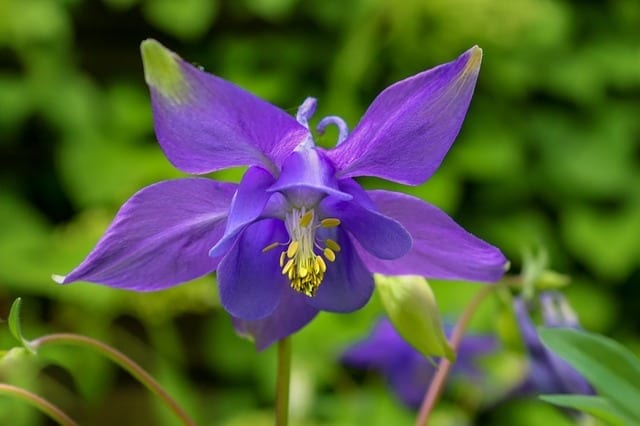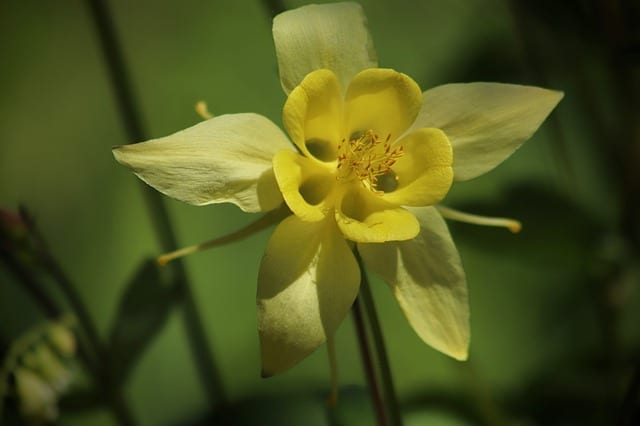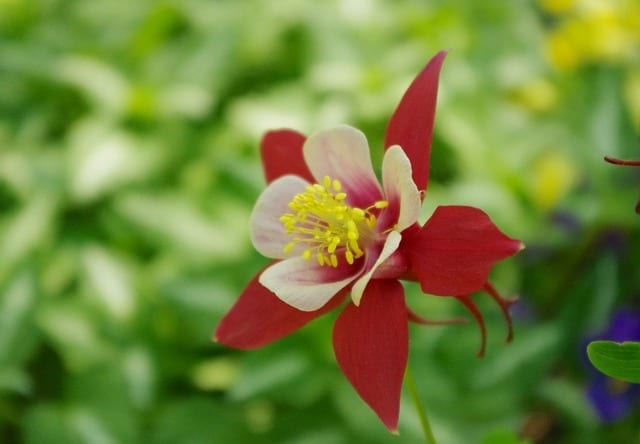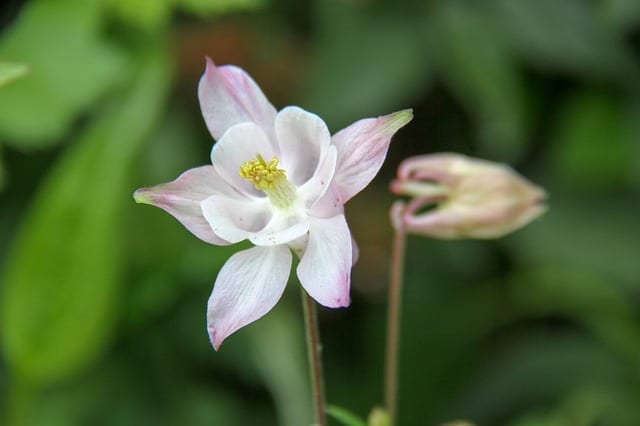
Last updated on May 20th, 2023 at 09:44 pm
Columbine or Granny’s Bonnet is scientifically known as Aquilegia. It is a genus of about 60-70 species of perennial plants. The spurred petals of their flowers are known throughout the Northern Hemisphere in forests, meadows, woodlands, and higher altitudes.
Because of the shape of the flower petals, which are supposed to resemble an eagle’s claw, the genus Aquilegia is derived from the Latin word for eagle (Aquila). Due to the inverted flower’s similarity to the five doves grouped, columbine originates from the Latin for dove.
Aquilegia caerulea is native to Colorado’s Rocky Mountains. Hiker Edwin James found this species of columbine flower in 1820. In 1915, the columbine flower was designated as the state flower of Colorado, and its song was designated as the state song.
The Rocky Mountain columbine was also voted Colorado’s favorite flower by Colorado schoolchildren in 1891. The Rocky Mountain Columbine received 14,472 votes out of 22,316 total votes cast.
The General Assembly passed a law in 1925 to protect the state flower, which is rare and delicate. The law made it illegal to uproot the flower on state land, and the number of blossoms and buds collected in one day is limited to twenty-five. On private land, columbines may only be picked with the landowner’s permission.
What does the Columbine flower symbolize?
Columbines can grow at heights as high as 9,000 feet, or almost to the timberline, in the Rocky Mountains. They are representations of aspiration since they can thrive at such great altitudes. The columbine inspires you to keep going and reach for the stars with its pointed, star-like outer petals.
The columbine is a hardy flower that can thrive in various harsh environments. As a result, they are also symbolic of tenacity and endurance. The columbine overcomes every impediment, much as a mountain climber patiently completing an ascent. Despite this, the columbine radiates a delicate beauty despite its ordeals.
The significance of the columbine flower is also linked to taking risks. The columbine is a flower that believes in “nothing ventured, nothing gained.” The columbine is the most symbolic of the Fool card in the tarot. Indeed, some historians believe the columbine’s link with folly stems from its form, which resembles a court jester’s hat.
Colorado’s state flower is the columbines. Schoolchildren banded together to make the lovely wildflower the state flower. The blue petals of the wildflower reminded them of the clear blue sky above the Rockies and the white petals of the snow-capped peaks. Furthermore, the gold pistils and stamens in the columbine’s center reminded them of the gold found in the highlands. As a result, columbines are also considered to be a symbol of good fortune and prosperity.
The columbine, being an alpine flower, is associated with spiritual elevation. The columbine reminds us that there is much more going on in the world than we see and feel. The columbine’s mantra is “Faith, not Fear.”
Columbine flowers have varied meanings in different civilizations, with Aphrodite, the goddess of love, being associated with the flower by ancient Romans and Greeks. Columbines are frequently associated with love and romance. That connotation has remained constant over time.
For millennia, columbines have held significant cultural and religious significance. Flowers represent the seven gifts of the Holy Spirit in Christianity. Indeed, they are frequently used to depict intelligence, piety, and devotion. They can also portray the fear of doing anything wrong in God’s eyes.
The columbine was thought to represent dreams and visions in Celtic mythology, and the blossoms were thought to function as doorways to other worlds. On the other hand, Austrians considered columbines to represent five doves flying in a circle.
The Vikings identified the columbine with the fertility goddess Freya in Nordic mythology. They even believed columbines were aphrodisiacs.
The columbine had certain unfavorable connotations in England during Shakespeare’s time. In general, they represented love’s lack of trustworthiness. According to A Shakespeare Garden, the poet and dramatist George Chapman (1559-1634) claimed that columbines symbolize ingratitude when he wrote: “What’s that—a columbine? No, I don’t have that thankless flower in my garden.”
Shakespeare also mentioned the columbine in Hamlet and his comedy Love’s Labor Lost. Even though there are other interpretations, it is widely assumed that the columbine symbolizes adultery and infidelity for Shakespeare.
Furthermore, the poet William Browne (1590 – 1645) thought that columbines signified lost or neglected love: “The columbine is tawny taken, Is thus ascribed to such as are forsaken.”
Ophelia, who is now believed insane, throws out flowers in court in Hamlet’s Act IV: “There’s fennel and columbines for you,” Ophelia tells King Claudius. Ophelia risks her life by bringing these two plants to the king due to their symbolic value. Fennel was a symbol of flattery. However, giving fennel to the king was a sexual jab because it wilted immediately after being picked. Columbines also represented adultery and folly, another dig at the king.
All in all, the columbine flower symbolic meanings are:
- fortitude
- courage
- endurance
- primal energy
- passion
- romance
- love
- wisdom
- strength
- peace
Meaning of the Columbine flower colors
Purple color

Spiritual progress and expanded consciousness are among the meanings of lavender and deep purple columbine flowers. They are linked to the seventh chakra, which governs your super-consciousness.
The purple columbine also represents peace—and the sacrifices that must occasionally be made to attain it. Purple is unique because it blends blue’s coolness with red’s warmth. So, a purple columbine is representative of a blending of differences and finding harmony.
Because the purple color is unusual, you should give it to someone who likes to stand out and is exceptional in many ways.
Yellow color

Flowers of this color are popularly used to convey a message of happiness and good fortune. Yellow columbine flowers are commonly associated with lightness, happiness, vitality, and vivaciousness. It is also a symbol of prosperity and friendship.
If you want to brighten someone’s day by surprising them with a yellow columbine flower, this is the flower to give them.
Red color

Columbines appear in a variety of colors, including fiery red and orange. Primal energy, passion, and romance are all represented by these colors. They also represent wealth.
Plant red columbines to infuse your life with more passion and vitality and strengthen the things that make you feel safe.
Furthermore, red columbines are a lovely gift for a lover. The red columbines, on the other hand, were associated with anxiety in Victorian culture.
It is also perfect for expressing your feelings and showing someone that you see them as something more than friends; give them a columbine flower. This is a bit straightforward, but it’s a nice way to let someone know you like them. The red columbine flower is a small flower with a powerful message of love.
White color

The connotation of the white columbine flowers is purity and innocence. Like the purple columbine, a white columbine represents the desire for spiritual enlightenment. Much like a white butterfly, a white columbine flower also represents angels and messages from loved ones who have passed away. They also add a touch of elegance and femininity, making it suitable for wedding arrangements and bouquets.
Interesting facts about the Columbine flowers
- According to the Forest Service, the columbine flower has been prevalent in North America for about 40,000 years. This flower spread from Asia to the rest of the world.
- If you’re wondering how the columbine flower survives drought conditions, look no further than its long taproots. The roots of the columbine flower are typically long, making it difficult to transplant.
- Columbine is said to have been used as a natural remedy by the Native Americans. They used Columbine-infused tea to heal everything from fever to heart tension to poison ivy pain.
- Native Americans used the flowers of many columbine species as a seasoning with other leafy greens. They were considered exceedingly sweet and harmless if ingested in modest amounts.
- On the other hand, the plant’s seeds and roots are exceedingly dangerous and contain cardiogenic chemicals that, when eaten, cause acute gastroenteritis and heart palpitations.
- Aquilegia root was used as a cure for ulcers by Native Americans in small quantities. However, because of its extreme toxicity, medical usage of this plant is considered dangerous; columbine poisoning can be fatal.
How to grow Columbine flowers
Columbine is useful for beds and borders as it comes in various colors, has a shallow root system, and grows in clumps.
- Plant the columbines in well-draining and loose soil.
- Avoid planting in any spot prone to waterlogging.
- Place them in a mixed shade to full sun throughout the day.
- Keep the plant’s soil evenly moist for the first month after transplanting.
- Water them once a week to 1 inch.
- Apply a half dose of general-purpose flower fertilizer in the spring.
How to care for Columbine flowers
- Maintain regular moisture levels of the soil during the germination and seedling stages.
- Once the plants are firmly established, water them once a week in the absence of rain.
- Weed out the plants that are growing adjacent to your prize specimens.
- Weed the garden on a regular basis to reduce water competition.
- Deadhead spent flowers throughout the growing season to foster new growth.
Best time to gift Columbine flowers
The columbine flower is an excellent choice for events such as greeting spring. These flowers could also be given to a friend or coworker as a token of appreciation.
Columbines can also represent faith, support, and the idea of victory. And that’s why a columbine flower is wonderful to offer someone who has recently received an award or achieved success in some way.
Columbines are a symbol of love as well. Depending on your chosen color, you can give it to someone you love romantically or otherwise. The columbine flower is tiny, but it can significantly impact someone’s day because we all want to live with love and hope. If anyone you value is going through a difficult time in their relationship, show them you care about them, love them, and have faith that it will all be fine soon.
Columbines would be an ideal gift for an ambitious friend with high goals, as they inspire and instill confidence and zeal in them. They also show your faith in them and their goals.
Usually, people associate the meaning of the columbine flower with a person’s character, especially since this flower is also a signifier of foolishness. Columbine flowers are a great gift for someone who enjoys jokes and has a sense of humor. However, be cautious when giving them to avoid sending the wrong message.
Conclusion
While the columbine flower carries its symbolic significance, it also conceals a hidden message that we must decipher if we want to give this flower to someone. Regardless of its size, the columbine flower is an effective and meaningful flower that has the potential to bring new energy into our lives.
Columbine flowers give a lovely and meaningful touch to any flower bed or garden.
If you want to know and learn more about flowers, we at PansyMaiden can help you. Check out our fun, easy-to-read, and informative flower-related content that you will surely enjoy!
